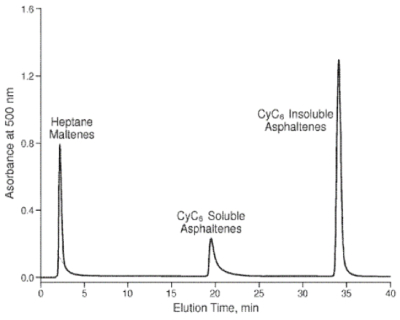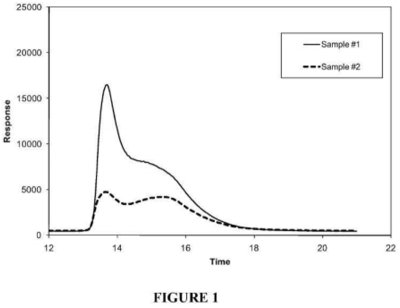Interferences were rendered unnecessary with the passage of the Leahy-Smith America Invents Act in 2011, but they linger in disputes between patents and applications claiming priority to applications filed before the change to a "first-inventor-to-file" system. The Federal Circuit recently upheld the Patent Trial and Appeal Board's priority determination in Chevron U.S.A. Inc. v. University of Wyoming Research Corp. in a decision based on the Board's construction of an undisputedly dispositive term.
U.S. Interference No. 106,064 was declared between the University of Wyoming Research Corp. (over involved U.S. Patent No. 8,367,425 and Chevron U.S.A.'s Application No. 12/883,814). The Count in the interference (which defines the interfering subject matter) was defined in the alternative as Claim 1 of the '814 application:
1. A method for determining asphaltene stability in a hydrocarbon-containing material having solvated asphaltenes therein, the method comprising the steps of:
(a) precipitating an amount of the asphaltenes from a liquid sample of the hydrocarbon-containing material with an alkane mobile phase solvent in a column;
(b) dissolving a first amount and a second amount of the precipitated asphaltenes by gradually and continuously changing the alkane mobile phase solvent to a final mobile phase solvent having a solubility parameter at least 1 MPa0.5 higher than the alkane mobile phase solvent;
(c) monitoring the concentration of eluted fractions from the column;
(d) creating a solubility profile of the dissolved asphaltenes in the hydrocarbon-containing material; and
(e) determining one or more asphaltene stability parameters of the hydrocarbon-containing material.
or
Claim 5 of the '425 patent:
5. A method for determining asphaltene stability in a hydrocarbon-containing material having solvated asphaltenes therein comprising the steps of:
(a) intentionally precipitating an amount of the asphaltenes from a liquid sample of the hydrocarbon-containing material with an alkane mobile phase solvent in a column that has a substantially chemically inert stationary phase established therein, wherein the substantially chemically inert stationary phase is substantially chemically inert relative to the precipitated asphaltenes;
(b) dissolving a first amount and a second amount of the precipitated asphaltenes by changing the alkane mobile phase solvent to a final mobile phase solvent having a solubility parameter that is higher than the alkane mobile phase solvent;
(c) monitoring the concentration of eluted fractions from the column;
(d) creating a solubility profile of the dissolved asphaltenes in the hydrocarbon-containing material; and
(e) determining one or more asphaltene stability parameters of the hydrocarbon-containing material;
wherein said step of dissolving comprises the step of dissolving by gradually and continuously changing the alkane mobile phase solvent to a final mobile phase solvent having a solubility parameter that is at least 1 MPa0.5 higher than the alkane mobile phase solvent.
Wyoming copied this claim to provoke the interference. Wyoming was designated as the Junior Party in the interference as declared, the Board recognizing their earliest priority date as September 23, 2011 (the filing date of U.S. Application No. 13/243,782, now U.S. Patent No. 8,273,581) and Chevron as Senior Party, having the benefit priority to U.S. Provisional Application Nos. 61/242,280, filed 14 September 2009 and 61/312,765, filed 11 March 2010). However, in its Decision on Motions, the Board granted Wyoming benefit of priority to U.S. Provisional Application 60/711,599 (filed Aug. 25, 2005), and U.S. Application No. 11/510,491 (filed Aug. 25, 2006), and declared Wyoming the Senior Party. Chevron filed a Priority Statement establishing its earliest conception date (supported by evidence of diligence from conception to its earliest filing date) of March 1, 2009. Accordingly, the Board held that Chevron was unable to establish its date of invention to be earlier than Wyoming's earliest priority date (the '599 application filing date) and entered judgment in favor of Wyoming. This appeal followed.
The Federal Circuit affirmed, in an opinion by Judge Schall joined by Judge Lourie; Judge Newman filed a dissenting opinion. The basis of Chevron's appeal was that the Board had erred in determining that Wyoming was entitled to its earliest filing date based on an erroneous claim construction. Specifically, Chevron contended that the Board had misconstrued the limitation "gradually and continuously changing the alkane mobile phase solvent to a final mobile phase solvent" to mean "the alkane mobile phase solvent is incrementally removed from the column over a period of time by continuously adding a final mobile phase solvent" (for the meaning of "gradually") and "without interruption" for the term "continuously." Chevron urged that this limitation should be construed to mean "the amount of alkane mobile phase solvent fed into the column is incrementally decreased from 100% to 0% over a period of time without interruption while the amount of final mobile phase solvent fed into the column is incrementally increased from 0% to 100% over the same period of time," as Chevron had argued before the Board. (Neither party disputed the construction given by the Board to the term "continuously.") The panel recognized that the appeal concerned that "one, narrow issue" of claim construction, because there was no dispute that "Wyoming's '425 patent and the priority applications have written description support for the limitation under the Board's construction, but that they lack such support under the construction urged by Chevron." Accordingly if the Board properly construed this term, Chevron was not entitled to priority for the Count.
The Federal Circuit majority (as had the Board) based its decision affirming the Board on express disclosure in the '814 specification regarding the term "gradually":
The term gradually as used herein shall be understood to mean that the alkane mobile phase solvent is incrementally removed from the column over a period of time by continuously adding a final mobile phase solvent having a solubility parameter at least 1 MPa0.5 higher than the alkane mobile phase solvent to the column.
(And because the Board thus relied on intrinsic evidence, it did not consider the testimony of either of the parties' expert witnesses and the Court's review was de novo.) On this basis, the Board (giving the limitation its broadest reasonable interpretation) held that the term "gradually and continuously changing" referred to the change of solvents in the column rather than at the inlet of the column (neglecting the physical reality that the introduction of the continuously changing solvent occurs, as it must, at the inlet, then proceeding through the column as chromatography continues). Chevron for its part argued (before the Board and here) that the '814 specification contained several instances wherein the solvent change was described as occurring at the column inlet. And Wyoming countered that these citations were directed to disclosure reciting where the solvent was gradually and continuously added not where the solvent was gradually and continuously changed.
The panel majority agreed that the Board had properly construed the dispositive limitation under the broadest reasonable construction standard, particularly in view of the express definition of the term "gradually" in the '814 application specification. The Court also found reliance to be supported by other disclosure in the specification in adjacent paragraphs. The majority rejected Chevron's legal argument that the Board decision was contrary to the Federal Circuit's precedent from In re Suitco Surface, Inc., 603 F.3d 1255 (Fed. Cir. 2010), stating that unlike in that case here, the Board's construction was not "unreasonably broad" and was supported by express disclosure. Because the majority found that the Board's construction was consistent with express disclosure and its own precedent regarding proper use of disclosure from the specification in construction under the broadest reasonable construction standard, the Federal Circuit affirmed the Board's priority determination in Wyoming's favor.
Judge Newman dissented. In the Judge's view, "[t]he Wyoming specification does not describe and does not support the claims copied from Chevron. In its chain of applications Wyoming describes and claims a different method." Thus the proper outcome would have been a determination that there was no interference in fact, particularly because the priority benefit accorded to Wyoming precludes Chevron's disclosure from being prior art to Wyoming's claims. The Judge expressly disagrees with the majority's lack of consideration of the standard of the Court's "uniform precedent that requires that the interference count is construed in light of the application from which it arose; that is, Haemonetics Corp. v. Baxter Healthcare Corp., 607 F.3d 776, 781 (Fed. Cir. 2010) and Bicon, Inc. v. Straumann Co., 441 F.3d 945, 951 (Fed. Cir. 2006)." As a consequence, in Judge Newman's view, the majority was able to ignore dispositive differences between the inventions claimed in the parties applications, namely that "Wyoming's method differed [from the claimed Chevron method] in that Wyoming required an abrupt and discontinuous solvent change" yet nevertheless granted priority to Wyoming. These differences (or the consequences thereof) were for Judge Newman illustrated in each of the parties disclosures:
Wyoming:
 Chevron:
Chevron:

And the Board understood these differences:
The underlying facts in this situation are, for the most part, not in dispute. [Wyoming's] example utilizes abrupt solvent input changes . . . , while [Chevron's] examples use solvent changes that are less so.
Because "[w]hen claims are copied to provoke an interference, the copied claims are [to be] construed in light of the application from which the claims are copies" the Judge opines, citing Agilent Techs., Inc. v. Affymetrix, Inc., 567 F.3d 1366, 1375 (Fed. Cir. 2009).
In addition, in light of these differences, Judge Newman believes that "Wyoming proved neither conception nor reduction to practice of the Count" (which is a function of the parties' priority status regarding Wyoming being declared the Senior Party and thus not having this burden). But both the law and PTAB rules (specifically 37 C.F.R. § 41.202) contain that requirement which was not complied with here. Seeing this as threshold issue, Judge Newman would have dissolved the interference and permitted both parties to have patents claiming their distinct inventions.
Chevron U.S.A. Inc. v. University of Wyoming Research Corp. (Fed. Cir. 2020)
Panel: Circuit Judges Newman, Lourie, and Schall
Opinion by Circuit Judge Schall; dissenting opinion by Circuit Judge Newman